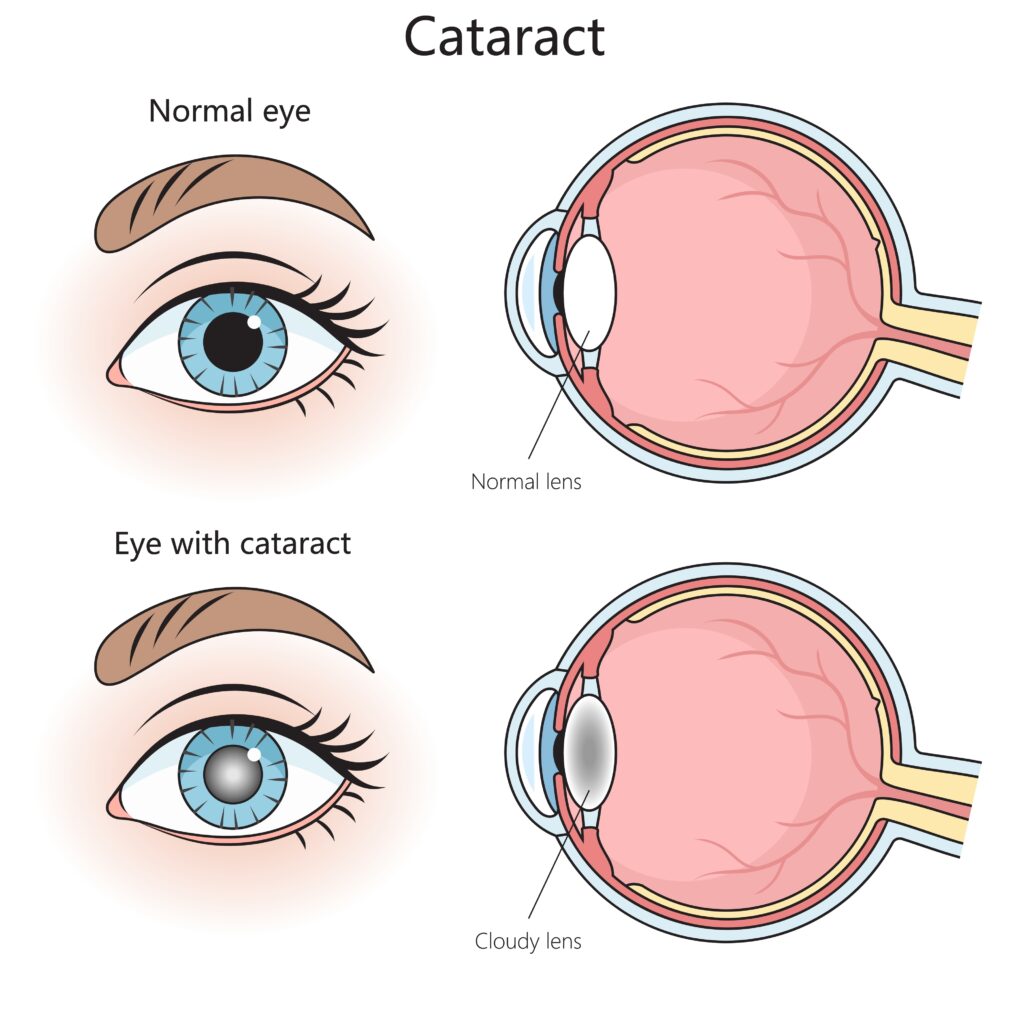Blog post by: Eye Physicians of Long Beach

Did you know that cataracts are the leading cause of blindness in the world? If left untreated, they can cause significant visual impairment over time and eventually blindness.
Recognizing the symptoms of cataracts can enable you to seek timely treatment, prevent further vision deterioration, and restore your sight.
Keep reading to learn more about the most common symptoms of cataracts!
Cataracts and Their Common Symptoms

A cataract is an eye condition that occurs when proteins inside the natural lens of the eye break down, accumulate, and cause clouding. With time, this clouding can grow bigger and cover more of your lens, blocking light from entering your eye.
The progression of cataracts varies from individual to individual and depends on the type of cataract. Most cataracts tend to progress slowly, taking years or even decades.
Other types can advance faster, causing vision loss more quickly, so you may require treatment for them sooner. Cataract surgery is the only way to eliminate cataracts permanently.
A cataract is painless and often doesn’t cause vision problems in the early stages. However, as it covers more of your lens, it can cause progressively worsening symptoms, such as:
Blurred or Cloudy Vision
Cloudy or blurred vision is the most common symptom of cataracts. Blurred vision can make objects at any distance appear out of focus or fuzzy. Your vision may also look hazy or cloudy.
It may feel as though you’re looking at the world through a foggy window. Cloudy or blurred vision occurs when the natural lens of your eye gets cloudier, scattering light and decreasing overall visual clarity.
Halos Around Lights
If you’re seeing halos, it could be due to cataracts. Halos are bright, colorful rings or circles that appear around lights, such as streetlamps and headlights.
They are most noticeable at night and can form when a cataract bends and scatters incoming light.
Sensitivity to Light and Glare

If you’ve become increasingly sensitive to glare and light, cataracts could be to blame. As cataracts progress, they can make it difficult for light to pass through the natural lens of your eye, scattering light in various directions instead of focusing it on the retina.
This can heighten your sensitivity to glare and light. As a result, bright light sources such as the sun, streetlights, and headlights from oncoming vehicles can seem too intense or even painful, causing you to squint, shield your eyes, or shut them.
Needing More Light to See
Do you require brighter lighting than you used to when performing indoor activities? Is it difficult to see when you’re outside in the evening? You may have a cataract.
When a cataract grows in size, it blocks more light from reaching your retina, making it harder to see in low light. You may find yourself requiring more light to read and see objects clearly in dim and low light.
Poor Night Vision
Difficulty seeing at night could signify cataracts. Cataract symptoms such as blurred vision, sensitivity to glare, halos, and double vision can compromise your night vision.
You can easily become blinded by glare from oncoming vehicle headlights or find it difficult to read road signs due to blurred or double vision, making it challenging to drive at night.
Driving at night with poor eyesight can put you and other road users at risk. If it’s become increasingly hard to see at night, it’s best to have someone else drive you until you see your ophthalmologist.
They can accurately diagnose cataracts and determine if you should have them removed to restore your night and overall vision.
Colors Appearing Faded or Yellow
With cataracts, once-vivid and bright colors may start to look washed out, brown, or yellow. A cataract can turn yellow or brown over time.
When light passes through it, it can take on the same color as your cataract, causing everything you see to appear yellow or muddy brown. This may diminish your ability to distinguish dark hues such as blue, black, and purple.
Additionally, a cataract can alter your perception of color. Clothes, shoes, and other items that you know are white may start to look yellow or brown because of the color of the cataract.
Double Vision in One Eye

A cataract can be the reason you’re experiencing double vision in one eye. It may distort how light passes through the natural lens of your eye, leading to double vision.
With double vision, you may see two or more images of the same thing side by side or on top of each other. This can be quite disorienting, making routine activities such as cooking, running errands, reading, texting, and watching TV challenging.
Frequent Prescription Changes
Another common symptom of cataracts is needing to change your glasses or contact lenses prescription more often than you used to, to see clearly. If your vision is changing rapidly, getting stronger contacts or glasses can help you see clearly, but it may not be long before you need a new prescription.
That could be a sign that your cataracts are progressing.
Second Sight
People with cataracts may experience a phenomenon called second sight, where their vision improves. You may find you can read without glasses if you have second sight.
However, second sight is short-lived, and your vision will deteriorate even further as the cataract continues to enlarge.
Determine What’s Causing Your Symptoms
If you’re experiencing any of the above symptoms, it’s essential to see our expert ophthalmologists. They can accurately diagnose cataracts and recommend the right time for their removal so you can regain clear vision and your independence.
Do you suspect you have cataracts? Schedule your appointment at Eye Physicians of Long Beach in Long Beach, CA, today to start your journey toward seeing clearly again and living your best life.
